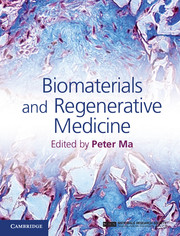Book contents
- Frontmatter
- Contents
- List of contributors
- Preface
- Part I Introduction to stem cells and regenerative medicine
- Part II Porous scaffolds for regenerative medicine
- Part III Hydrogel scaffolds for regenerative medicine
- 14 Polysaccharide hydrogels for regenerative medicine applications
- 15 Functionalized poly(ethylene glycol) hydrogels for controlling stem cell fate
- 16 Fumarate-based hydrogels in regenerative medicine applications
- 17 Hydrogel scaffolds for regenerative medicine
- 18 Microfabricated gels for tissue engineering
- 19 Organ printing
- Part IV Biological factor delivery
- Part V Animal models and clinical applications
- Index
- References
15 - Functionalized poly(ethylene glycol) hydrogels for controlling stem cell fate
from Part III - Hydrogel scaffolds for regenerative medicine
Published online by Cambridge University Press: 05 February 2015
- Frontmatter
- Contents
- List of contributors
- Preface
- Part I Introduction to stem cells and regenerative medicine
- Part II Porous scaffolds for regenerative medicine
- Part III Hydrogel scaffolds for regenerative medicine
- 14 Polysaccharide hydrogels for regenerative medicine applications
- 15 Functionalized poly(ethylene glycol) hydrogels for controlling stem cell fate
- 16 Fumarate-based hydrogels in regenerative medicine applications
- 17 Hydrogel scaffolds for regenerative medicine
- 18 Microfabricated gels for tissue engineering
- 19 Organ printing
- Part IV Biological factor delivery
- Part V Animal models and clinical applications
- Index
- References
Summary
Introduction
An emerging trend in tissue engineering and regenerative medicine is the design of scaffolds that recapitulate a stem cell’s extracellular microenvironment, or “niche” (Cushing and Anseth 2007; Tibbitt and Anseth 2009). While the exact constituents of a stem cell niche are not well characterized, it is generally believed that morphogens, immobilized extracellular matrix (ECM) components, cell–cell interactions, and matrix elasticity are the major determinants that direct stem cell self-renewal or differentiation (Lutolf and Hubbell 2005). Research over the years has accumulated fundamental knowledge about stem cell biology in vitro. Most of the results were obtained from experiments conducting on flat, rigid, and two-dimensional (2D) tissue culture polystyrene (TCPS). These 2D environments, however, might not truly reproduce what a stem cell experiences in vivo, where relevant biological and biophysical cues are produced in a far more complex and spatially and temporally regulated manner. In fact, results from numerous studies have demonstrated that, compared with cell culture on TCPS, stem cells behave differently when cultured in three-dimensional (3D) matrices (Liu and Roy 2005; Ingber et al. 2006; Lee et al. 2008b; Lund et al. 2009).
Artificial matrices of synthetic or natural origins have been developed for culturing stem cells in 3D (Lee et al. 2008b; Lund et al. 2009). While natural ECM components, such as collagen and laminin, provide intrinsic biological recognition sites for cell attachment and migration, these natural matrices are ill-defined and poorly controlled with respect to their compositions and mechanical properties, respectively. Furthermore, one cannot afford to overlook the immunogenicity problems associated with allogenic or xenogenic materials, since this significantly limits the clinical translatability/relevance of stem-cell-based therapy. Matrices fabricated from synthetic polymers, on the other hand, provide well-defined and user-controllable chemical and physical properties (Nuttelman et al. 2008). The use of synthetic matrices, however, is not without challenges, insofar as synthetic polymers usually lack biological motifs for cellular recognition. Hence, significant efforts have been dedicated to fabricating synthetic polymeric scaffolds functionalized with biomimetic motifs that permit cellular interaction.
- Type
- Chapter
- Information
- Biomaterials and Regenerative Medicine , pp. 263 - 278Publisher: Cambridge University PressPrint publication year: 2014



